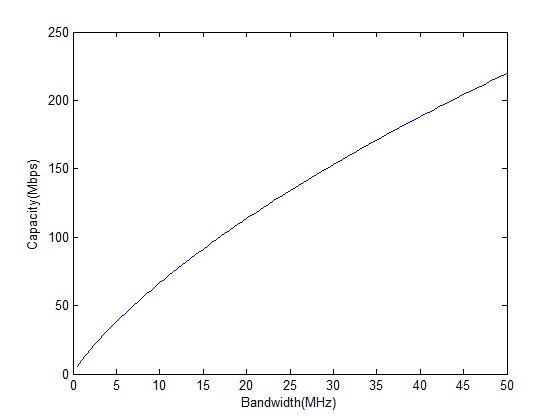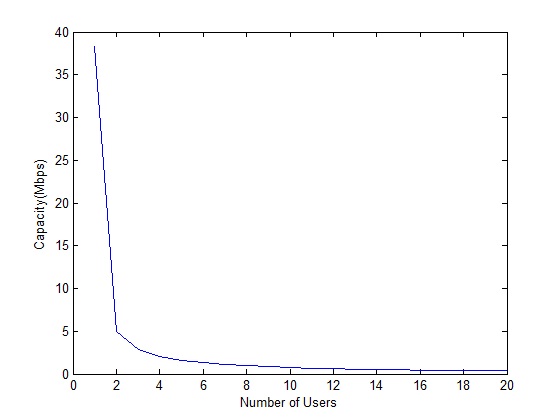The capacity of any wireless communication channel is given by the well known Shannon Capacity Theorem:
C=B*log2(1+SNR)
or
C=B*log2(1+P/(NoB))
where C is the capacity of the channel in bits/sec, P in the noise power in Watts, No is the noise power spectral density in Watts/Hz and B is the channel bandwidth in Hz. It is obvious that the channel capacity increases with increase in signal power. However, the relationship with bandwidth is a bit complicated. The increase in bandwidth decreases the SNR (keeping the signal power and noise power spectral density same). Therefore the capacity does not increase linearly with bandwidth.

It is assumed that the signal power is -80dBm and the noise power spectral density is -170dBm/Hz.
Let us now consider the case of a WCDMA system where the noise component consists of the AWGN noise as well Multiple Access Interference (MAI). The above capacity formula is then modified as:
C=B*log2(1+SINR)
or
C=B*log2(1+P/(NoB+(U-1)*P))
where U is the number of users.

It is assumed that WCDMA system has a bandwidth of 5MHz, signal power of -80dBm and noise power spectral density of -170dBm/Hz. It is observed that the capacity of the WCDMA system decreases exponentially with increase in number of users (all users are assumed to have equal power at the receiver). The capacity of a 5MHz channel drops from about 38Mbps for a single user to about 370kbps for 20 users (the combined capacity of 20 users is 7.4Mbps which is much lesser than the capacity of a single user in AWGN only).
Note:
1. In some references the signal power is adjusted by the processing gain but I think that this is not correct for capacity calculations because in that case the bandwidth should be adjusted as well.
2. The capacity in fading environments would be less than AWGN capacity. However, multi-antenna systems allow for higher capacities.
Author: Yasir
More than 20 years of experience in various organizations in Pakistan, the USA, and Europe. Worked with the Mobile and Portable Radio Group (MPRG) of Virginia Tech and Qualcomm USA and was one of the first researchers to propose Space Time Block Codes for eight transmit antennas. Have publsihed a book “Recipes for Communication and Signal Processing” through Springer Nature.